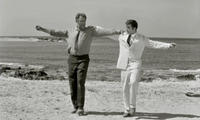HISTORY
The Greek folk dance group Pigasos (Pegasus in Dutch) was founded in 1963 by young Greek migrants from Utrecht (YouTube video In Greek) in the Netherlands. In the beginning, the dance group consisted of a group of friends without a name. On October 25 (Greek Liberation Day) of that year they gathered to perform Greek folk dances wearing borrowed costumes. |
The movie Zorba the Greek
In 1964 the film Zorba de Griek with Antony Quinn and Irini Papas in the lead roles premiered in the Netherlands. The film was based on the book of the same name by Nikos Kazantzakis and with film music written by Mikis Theodorakis. Especially the dance scene from the movie with the famous words of Zorba (Antony Quin) to his friend (Alan Bates): "Dance? Did you say... DANCE?! Come on my boy, Together! Lets go!" and then the dance to the beautiful music, sparked a real craze to get to know the Sirtaki, the Greek music and the country of Greece. |
The dance group got the mythological name Pigasos when Aunt Beatriki from Athens visited Dimitra Sideri (1923-1999) and Nikos Sideris (1920-1997). Dimitra Sideri was one of the co-founders of Pigasos and was the driving force behind the dance group for many years.
In 1964, Pigasos even received a letter from the then Greek ambassador in The Hague. Mr Grívas-Gardikiòtis: We hereby inform you that, thanks to the great efforts of your company Pigasos, the successful performances of our Greek dances and their spread among a large number of Dutch people, the tourism of Dutch people in Greece has increased by thirty percent this year. increased. Our warmest congratulations and good luck for the future!
Over time, an orchestra was even formed with instruments from different regions of Greece. The group members taught each other the dances from their native region, as was the case in the villages of Greece.
Pigasos became more and more famous and the company was divided into two groups: a performance group and a beginners group. These beginners were then eventually advanced again. After a while, the group that performed also included Dutch people. Thus Pigasos gradually became also a symbol of fraternization and harmonic coexistence based on Greek dances.
Pigasos performed in theaters at home and abroad, even appeared on television. At the end of each performance, the members of Pigasos asked the audience to come forward and join the dance. Something that still happens to this day.
With the money they earned from their performances, they made and bought new costumes. Mrs. Dimitra Sideri even went to villages in Greece to buy up traditional costumes for the dance group. There were also members such as Mrs. Sirma Papadamakis, who lent her dowry of homemade clothing to the dance group.
Very important was also the willing help of Mrs. Elèni Tsaóuli, the famous Greek dance teacher, founder and director of the folk dance company 'Elèni Tsaóuli', which was very famous in Greece for her meticulous work and her research into Greek dances. She showed great interest in Pigasos - a great honour! - and came to the Netherlands. She taught and had costumes brought in from Greece. After her death, her work was continued by her assistant, successor and friend Ms. Plousía Liakatá. She also came to the Netherlands for many years to give dance lessons and to help with sewing costumes.
60 years of Pigasos
In 2023, the dance group will celebrate its 60th anniversary. Sixty years of dancing; whole families, several generations, have learned to dance at Pigasos. Some dancers got to know each other at the dance group and got married. Pigasos has long been the only place where the Greek youth could gather. Getting together to dance has helped them to maintain their Greek identity.
.jpg/picture-200?_=17fc7c58120)
